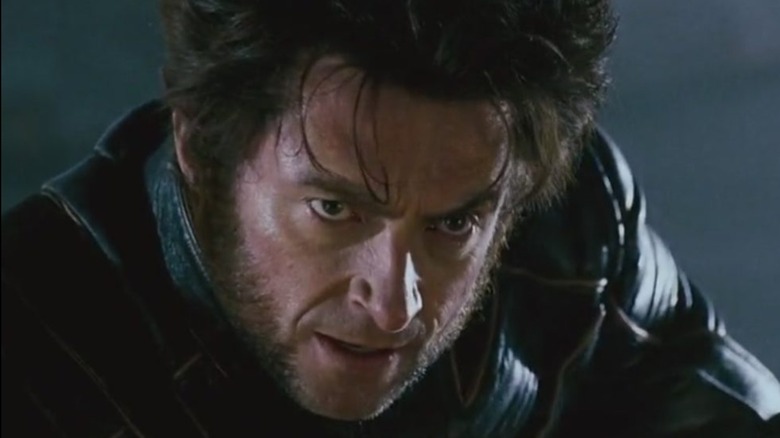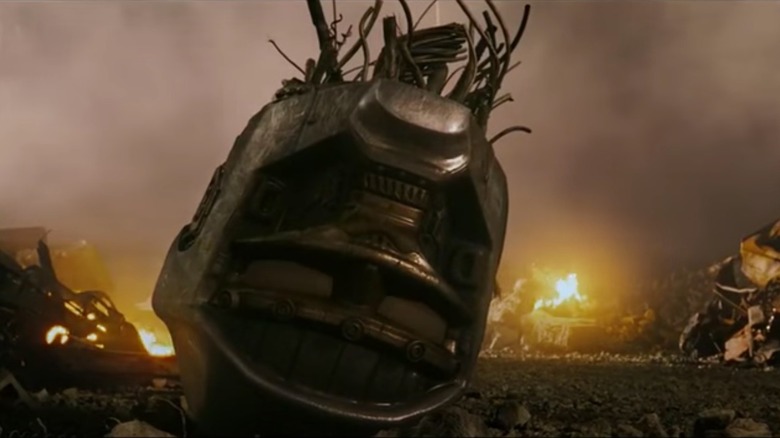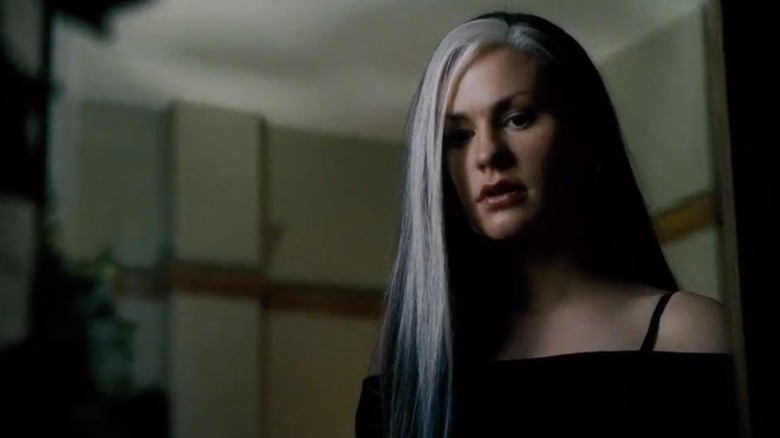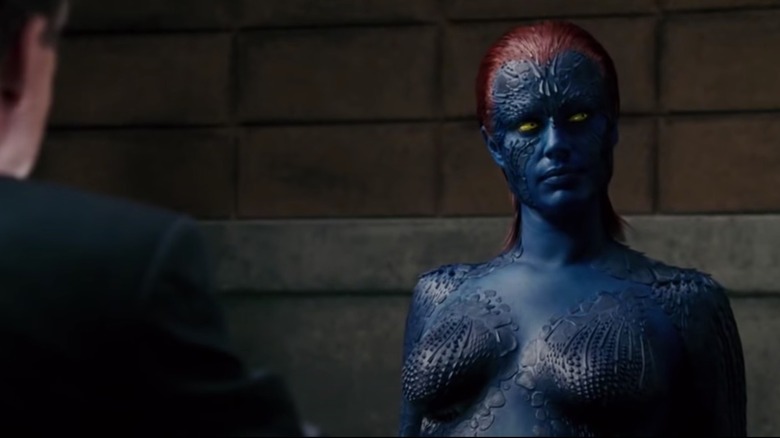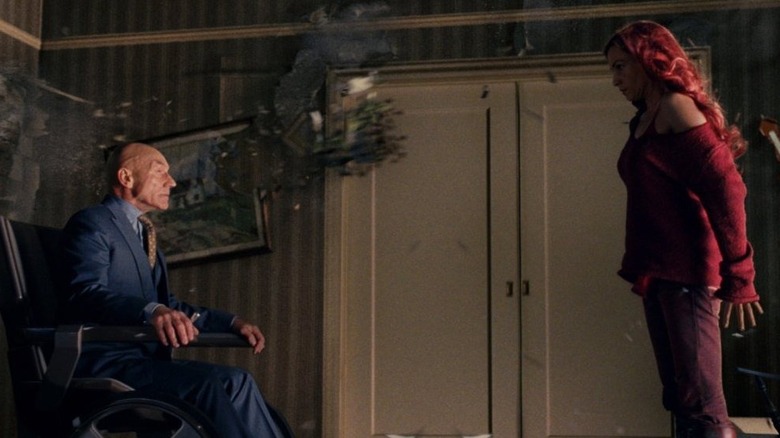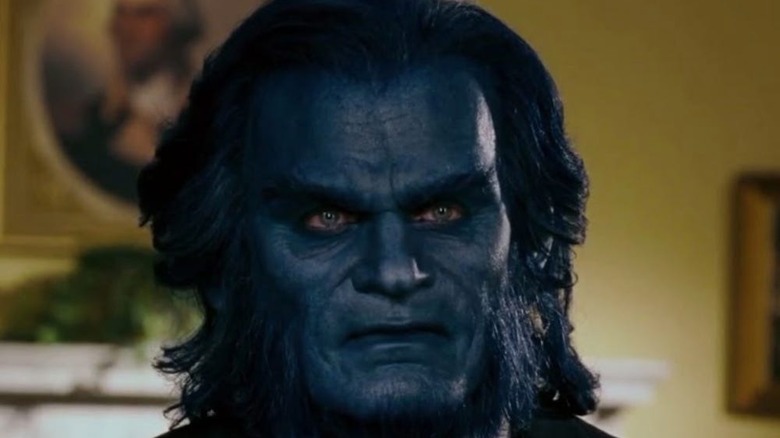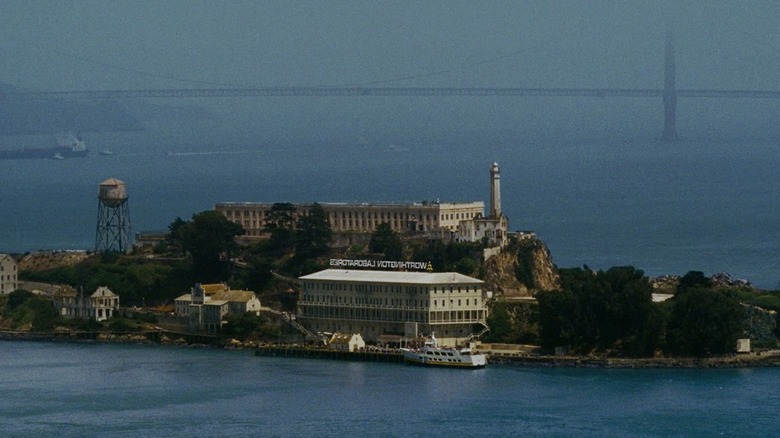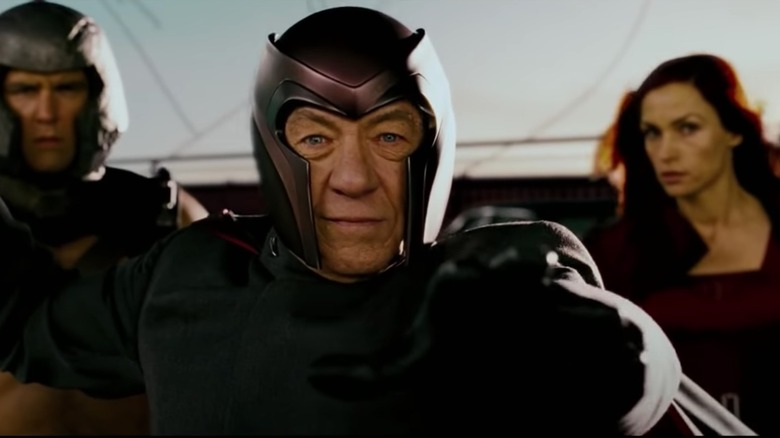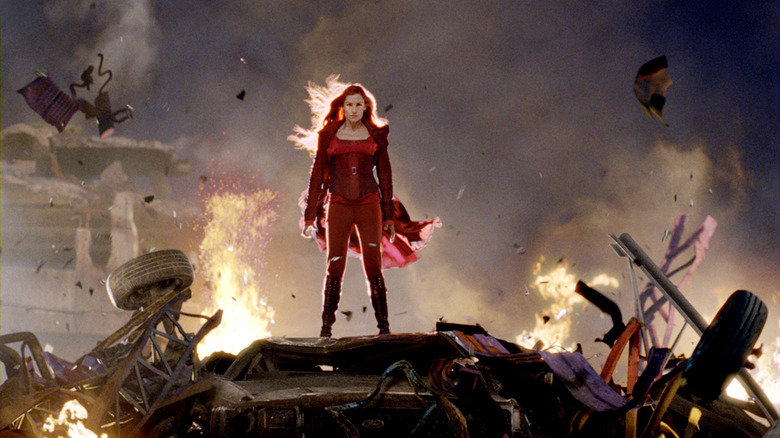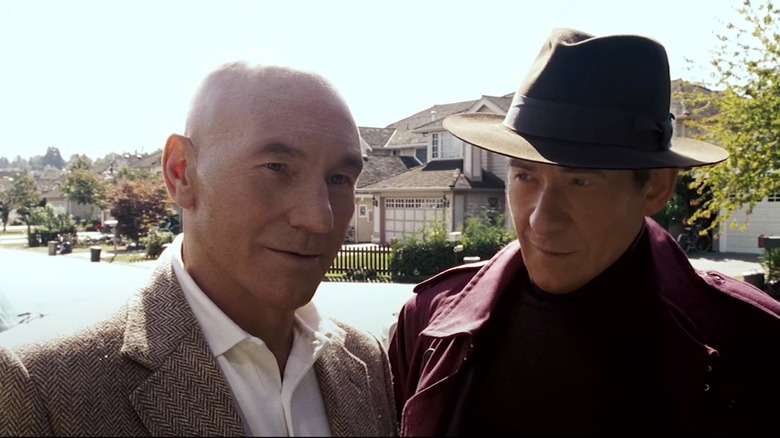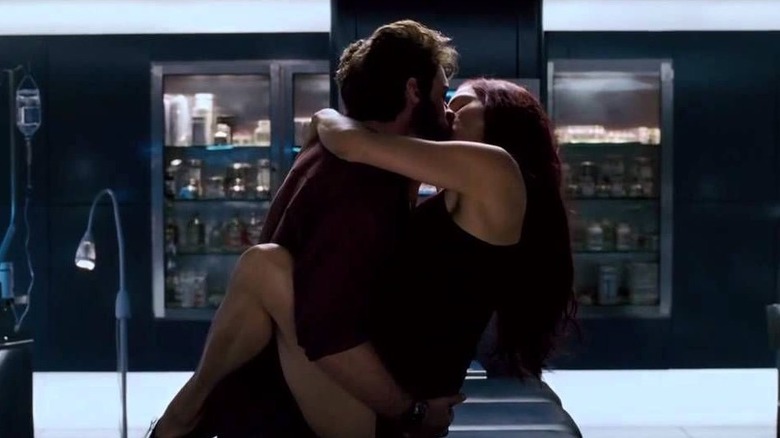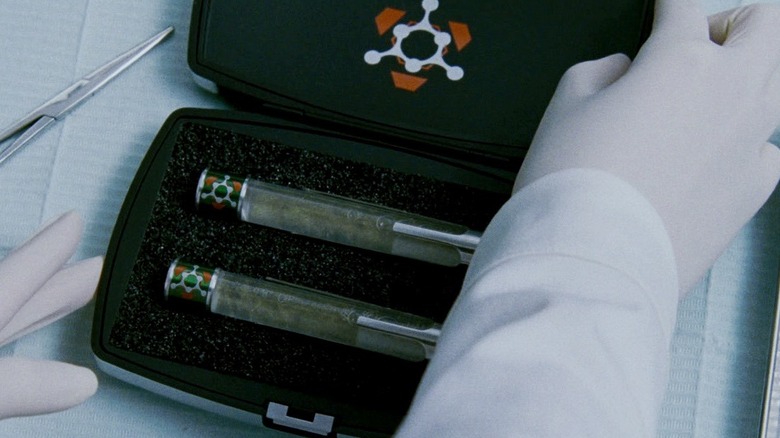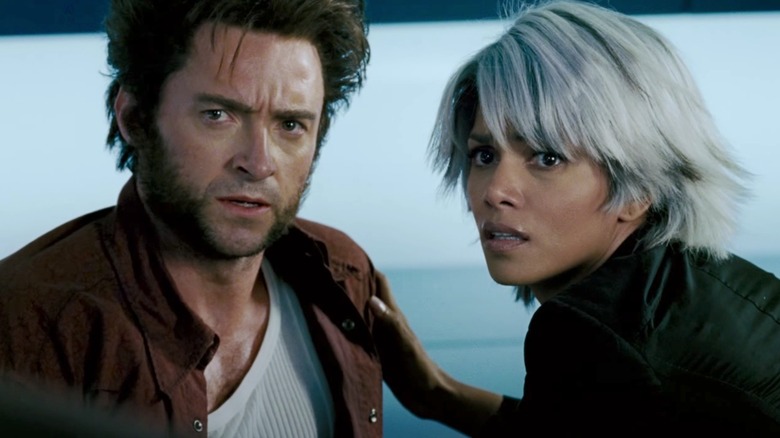Things Only Adults Notice In X-Men: The Last Stand
"X-Men: The Last Stand" is generally regarded as the weakest film in the original X-Men trilogy. Drawing criticism from fans after its release in 2006, audiences weren't happy to see characters like Professor X (Patrick Stewart) and Cyclops (Scott Speedman) die in director Brett Ratner's vision, whilst other fan-favorites like Magneto (Ian McKellen), Mystique (Rebecca Romijn), and Rogue (Anna Paquin) were de-powered after taking the mutant cure. Viewing "X-Men: The Last Stand" from a younger age makes it easy to overlook many of the movie's mistakes in favor of Wolverine's (Hugh Jackman) fight scenes and Jean Grey's (Famke Janssen) epic feats of power. Although for adult viewers, there's a lot that doesn't slip through the cracks, for better and for worse.
Many of the movie's better qualities are also magnified when watching it from an adult's perspective. The film makes reference to important moments from history such as the Civil Rights movement, whilst offering a metaphor for injustice and discrimination with its portrayal of the mutant characters. The third X-Men movie in 21st Century Fox's franchise could be considered a nuanced story of political struggle, erasure, and the ethics of power. The story, however, isn't perfect. While great for younger viewers, what are the jokes and easter eggs that only adults might notice?
Why are the X-Men training mutants with non-combative powers like Rogue?
In the beginning of "X-Men: The Last Stand," the X-Men are shown practicing for battle in a simulated fight against a Sentinel. Wolverine and Storm (Halle Berry) attempt to teach young mutants Iceman (Shawn Ashemore), Colossus (Daniel Cudmore), Rogue, and Kitty Pryde (Elliot Page) how to defeat powerful enemies using their mutant abilities. The lesson goes awry when the Sentinel overwhelms the students, prompting Wolverine to cut the class short by taking out the robot himself. For younger viewers, the simulated battle is another fun piece of action that gets to showcase each character's powers. For adults, however, it's easy to question the purpose of this lesson, and why Logan and Storm thought it was a good idea in the first place.
Training mutants with combative powers is wise, but why is Rogue on the battlefield? As seen in the previous X-Men movies, Rogue's abilities are powerful but limited. She can absorb the powers of other mutants and the life force of humans by touching them, and prolonged physical contact can render her victims unconscious and even kill them. Against a Sentinel, there's not much that Rogue can do. Her presence is more a liability. If Rogue had her additional powers of flight, invulnerability, and superhuman strength from the comics (which she absorbed from Ms. Marvel aka Carol Danvers) then her presence on the simulated battlefield would be understandable. Without them, it's pretty baffling why the X-Men would endanger her like that.
Bobby is a terrible boyfriend to Rogue
It's hard not to feel sorry for Rogue throughout "X-Men: The Last Stand," particularly when it comes to her relationship with Bobby aka Iceman. The couple meet in the first X-Men movie, released in 2000, when Rogue and Wolverine are taken in by Professor Xavier and given sanctuary from Magneto at the X-Mansion. Rogue's romance with Bobby is an important part of the 2003 sequel "X2," which features several sweet moments between the young mutants. During the third film of the franchise, however, there is a sudden distance between Rogue and Bobby, resulting in Rogue taking the mutant cure and giving up her powers whilst Bobby pursues a new relationship with Kitty Pryde.
Viewing "X-Men: The Last Stand" from an adult's perspective only serves to highlight just how terrible Bobby is to Rogue. From the beginning of the movie, Bobby and Kitty's flirtation is obvious to everyone — including Rogue, who can't be intimate with her boyfriend or even share a hug without hurting him. Professor X's death further drives a wedge between them; rather than be with Rogue, Bobby takes Kitty out ice-skating, and doesn't notice until the following morning that his girlfriend has left the mansion. Bobby's behavior is easy to overlook for a young viewer, but as an adult his actions towards Rogue make him pretty unlikable.
Mystique references Malcom X and the Civil Rights Movement when she refers to her "slave name"
The X-Men series was created by Stan Lee and Jack Kirby, debuting its first comic book issue in September 1963. In an interview with the Guardian in 2000, Lee spoke about the early days of the X-Men and how he was inspired to make them a "good metaphor for what was happening with the civil rights movement in the country at that time." The mutants were written as an allegory for racial injustice and the fight for equality happening in the US throughout the 1960s, spearheaded by figures such as Martin Luther King, Jr and Malcom X. Their views influenced the characters of Professor X and Magneto, two mutants with different ideas when it comes to integrating with humans.
Mystique makes a reference to Malcolm X during her interrogation in "X-Men: The Last Stand." When the interrogator calls her by her alternate name, Raven, Mystique rebuffs him by informing him "I don't respond to my slave name." Malcolm X, previously known as Malcolm Little, changed his surname after converting to the Nation of Islam to rid himself of his perceived slave name. Mystique's line here draws connections to Malcolm X as well as the opposing views during the Civil Rights movement that influenced the series.
Professor X and his students have an ethical discussion about the misuse of power
"X-Men: The Last Stand" explores different themes of morality, ethics, and injustice, some of which are directly discussed during one of Professor X's lessons with a small group of students. Early in the film, the professor sparks a discussion with Kitty Pryde and her peers by suggesting that "when an individual acquires great power, the use or misuse of that power is everything." Xavier is giving his students similar advice to Uncle Ben's classic line in the Spider-Man series here; "with great power comes great responsibility." As dazzling a spectacle as it is to see heroes like Storm, Cyclops and Jean Grey use their powers to defeat villains, what separates heroes and villains is that heroes don't abuse their abilities — using them to help "the greater good" instead of for "personal or destructive ends."
A lot of the ethical discussions here probably won't register with younger viewers, but understanding the mutant dilemma from an adult's viewpoint highlights the movie's qualities — as well as what makes the mutants stand out from other Marvel figures. Throughout "X-Men: The Last Stand," the characters are forced to decide whether to use their powers for "the greater good" or "destructive ends." Wolverine, Storm, and Beast (Kelsey Grammar) choose the greater good by protecting the facility and advocating for equal rights, whereas other characters like Magneto and the Phoenix choose destruction.
Hank is wrong — Wolverine is a lot older than him
The third X-Men movie introduces fans to Hank McCoy aka Beast, a founding member of the team from the comics. A prominent political figure working for mutant rights, Hank reunites with Storm and Professor X at the X-Mansion to discuss the mutant cure. Whilst there, Hank also meets Wolverine ... and the two don't exactly hit it off. Wolverine asks "who's the furball?" prompting a strained reply from Hank. Everything goes downhill, and it isn't long before the two clash, with Hank sharply telling Logan: "My boy, I was fighting for mutant rights since before you had claws."
This is another line that's easy to disregard for younger viewers, but most adult fans who have watched every X-Men movie will know that this isn't technically true. In "X-Men Origins: Wolverine," it is revealed that Logan was born in 1832, roughly sharing an age with his comic book counterpart. His mutant powers include rapid healing and a slowed ageing process, making him older than the other X-Men, including Beast and Professor X. Hank's comment could be taken to mean that he was a mutant advocate before Wolverine got his adamantium claws, though this would still be a technical error considering Logan originally had claws of bone.
The dark history of Alcatraz Island
Alcatraz Island features in "X-Men: The Last Stand" as the location of the mutant cure facility, where young mutant Jimmy aka Leech (Cameron Bright) is kept. During the final act of the film, Magneto leads Jean Grey and the Brotherhood of Mutants in a devastating attack on the island, redirecting the Golden Gate Bridge before ordering an assault on the human guards. The attacking mutants try to capture and kill Jimmy to stop his DNA from being used to create the cure. Luckily, Jimmy is rescued by Kitty Pryde, and the two escape from the facility.
Alcatraz has a dark history in real life that corresponds to its use in "X-Men: The Last Stand." Fort Alcatraz has been a military prison and a federal prison, known as Alcatraz Federal Penitentiary, with the strong currents surrounding it making escape close to impossible. A tourist attraction now, Alcatraz was one of the world's most famous prisons in the past, which relates to its depiction in the third X-Men film. Jimmy's room at the facility resembles a prison cell, symbolizing how he has been imprisoned by humans who would feel more comfortable locking mutants away from the rest of the world.
Magneto is a hypocrite
On the surface, Magneto is a sympathetic villain. His origins (explored further in "X-Men: First Class") include being kept in a concentration camp during World War II, where his parents were ripped away from him and he was subjected to countless horrors at the hands of the Nazis. Magneto's methods are extreme, but as Sam Wilson from "The Falcon And The Winter Soldier" would say, he's "motivated by different things." Magneto, like Professor X, fights for mutant rights in a world where mutants are discriminated against. However, the metal-manipulating mutant loses sight of his own goals during "X-Men: The Last Stand" and becomes a hypocritical tyrant happy to sacrifice mutant lives for his agenda.
During the movie, Magneto declares that "enough mutant blood has been spilled" and rallies his fellow mutants against their "true" enemy: humans. It isn't long before he begins to contradict himself, however. Despite winning the allegiance of countless mutants and forging the Brotherhood, Magneto shows the majority of them little regard and even sacrifices many in the attack on Alcatraz Island, smugly telling Pyro (Aaron Standford) "that's why the pawns always go first." Magneto might believe everything he does is for mutantkind, but his disregard for his followers' lives and well-being show how little he really cares.
There's a lot of brutality and death in X-Men: The Last Stand
Anyone can see the sheer amount of death during "X-Men: The Last Stand." Multiple characters die, including main team members like Professor X, Jean Grey (again), and Scott Summers aka Cyclops. Even outside of the central story, the conflict between humans and mutants reaches a blood crescendo that claims the lives of countless people from both sides, particularly during the final battle on Alcatraz Island. The human soldiers defend the facility with non-fatal plastic weapons containing the cure, but in the end nearly everyone is consumed by carnage when the Phoenix unleashes her powers.
What younger viewers might fail to appreciate is the particularly brutal ways a lot of characters die. Pyro uses his fiery abilities to burn people to death, Quill (Kenneth Leung) impales a woman with his retractable spikes, whilst the Phoenix disintegrates her victims with her unparalleled psionic abilities. Magneto's attack on the Golden Gate Bridge is especially ruthless; hundreds of innocent people would have died during the chaos of the bridge being broken and redirected. The stakes are higher than they've ever been during this movie, as many mutants unleash the destructive capabilities of their powers.
Professor X isn't totally a good guy
Even good guys like Charles Xavier have to make ethically questionable decisions for the greater good sometimes. When Jean Grey is discovered alive at Akali Lake by Storm and Wolverine, Logan brings her back to the mansion and has a startling discussion with the professor. Xavier reveals that, as a child, Jean's telekinetic powers were so limitless that they posed a danger to everyone, human and mutant alike. To protect the world, Xavier used his telepathic abilities to build psychic blocks in Jean's mind that repressed her darker side. This alter-ego came to call itself the Phoenix, an all-powerful godlike creature with no remorse, driven entirely by instinct.
Wolverine is disgusted by Xavier tampering with Jean's mind, and it's not hard to see his point here. Professor X acted without Jean's consent or knowledge, causing irreversible damage to her psyche by locking away her true power instead of teaching her to control it. Xavier's choice was understandable, but still reprehensible. This further blurs the lines between heroes and villains, as heroic characters like Xavier are shown to behave villainously in the best interests of the greater good. The reality of Xavier's actions may not be as clear to younger viewers, but adults are more likely to notice the moral conundrum Professor X faces — and decide for themselves whether he made the right choice.
Logan doesn't immediately question why Jean is kissing him.
To Logan's shock and delight, he reunites with the woman he loves during "X-Men: The Last Stand" when Jean is located alive and well at Alkali Lake, despite seemingly dying at the end of "X2." Jean is taken back to the mansion, where Xavier reveals the truth about her dark alternate persona, the Phoenix. Logan knows that Jean's psyche is compromised and that Jean's boyfriend Scott is missing. Yet when she wakes up and begins to kiss him, behaving uncharacteristically, Logan doesn't question a thing — going along with Jean and sharing a passionate embrace in the mansion's medical wing.
Logan and Jean share a flirtation in "X-Men" and "X2," with their love triangle with Scott drawing inspiration from the comics. Nevertheless, in the movies Jean has made it clear that she loves Scott and he is her partner, not Wolverine. Immediately waking up and forgetting all about Scott should have been a red flag for Logan, especially after he was just informed about the Phoenix by Professor X. Logan and Jean's raunchy moment was something most fans saw coming as a result of their chemistry throughout the films, though only adult viewers are likely to notice how quickly Logan abandons reason as soon as the Phoenix kisses him.
The mutant cure storyline references the LGBTQ Rights movement
The story of the cure is adapted from the comics, in particular Joss Whedon's "Astonishing X-Men" Volume 3, running from 2004 to 2013. In "Gifted," issues 1-6, mutants are presented with a cure that will suppress their abilities, tempting mutants with noticeable physical alterations like Beast. In "X-Men: The Last Stand," the X-Men discuss the so-called cure for mutants, with Storm declaring: "They can't cure us. You wanna know why? Because there's nothing to cure." Storm, and other mutants like her, oppose the creation of the cure because it treats mutanthood like a disease, an illness that needs to be overcome. Storm tells Rogue "there's nothing wrong with you," and makes it clear that she is proud to be a mutant.
The X-Men series has included more and more LGBTQ Rights subtext in recent years, and the cure storyline references attempts to "cure" the LGBTQ community in history with conversion therapy. The cure is a temporary plot point that is abandoned by humanity as they come to realize that Storm is right; mutanthood is not a disease, and doesn't need a cure. Instead, the world needs to come together as a more accepting place for all people, human and mutant. The X-Men have featured several LGBTQ members in the comics in recent years, including Iceman (who was outed by Jean Grey in 2015 when she read his mind), Northstar and the Scarlet Witch's son, Wiccan.
The possible sexual tension between Storm and Logan
Jean Grey is the love of Wolverine's life in the X-Men films, but it could be argued that she wasn't the only team member he developed feelings for. Did Storm and Logan have Han Solo and Princess Leia-like chemistry during the original X-Men trilogy's third instalment? The opening training scene in the danger room features the two disagreeing about what approaches to take with the students. Logan tells Storm "don't get your panties in a bunch," before taking out the Sentinel. Later, the two have another tense encounter regarding Jean. Despite their disagreements, the two fight side-by-side all throughout the film. They are there to comfort each other in the wake of Professor X's death; without him, Scott and Jean, they become the last of the X-Men.
Storm and Wolverine have shared a romantic tryst in the comics. Although Storm is more often linked to T'Challa, the two parted ways in 2012's "Avengers vs X-Men," with Storm and Wolverine pairing up shortly after. The filmmakers could have been influenced by their comic book counterparts when determining Storm and Logan's arc in "X-Men: The Last Stand," leaving subtle hints that only adult viewers would pick up on, along with the rest of the subtext scattered throughout the film.
